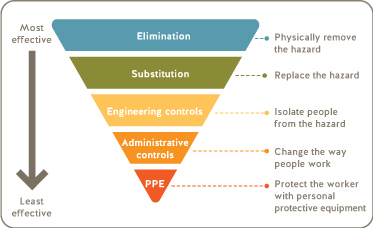| |
|
Controlling hand-arm vibration exposure and risk reduction 
There are many controls that can be implemented to reduce the risk of exposure to hand-arm vibration (HAV). When considering what controls to implement, you should always follow the hierarchy of controls and start with those that are the most effective. The two main factors that affect the risk of exposure to HAV are the vibration level and the frequency/duration of exposure. Reducing the vibration level
Reducing exposure frequency and duration In addition to reducing the vibration exposure level, reducing exposure frequency and duration can help minimize the risk of HAV exposure. An effective and easy method for reducing exposure duration is to introduce job rotation and take frequent breaks. Where time and scheduling allow, consider spreading the tasks requiring use of handheld power tools or hand-guided equipment over multiple days. Control exposure to cold Exposure to the cold significantly increases the risk of exposure to HAV. Move work indoors where possible, and use portable heaters or wear warm and dry gloves when working in cold conditions. Wrap metal handles to provide thermal insulation. Read more We're here to help For resources, please visit worksafebc.com/ergonomics. If you have questions about ergonomics, human factors or need help managing the risk of MSI in your workplace, please contact us at HumanFactors@worksafebc.com | |
 |
WorkSafeBC, PO Box 5350 Stn Terminal, Vancouver BC V6B 5L5
